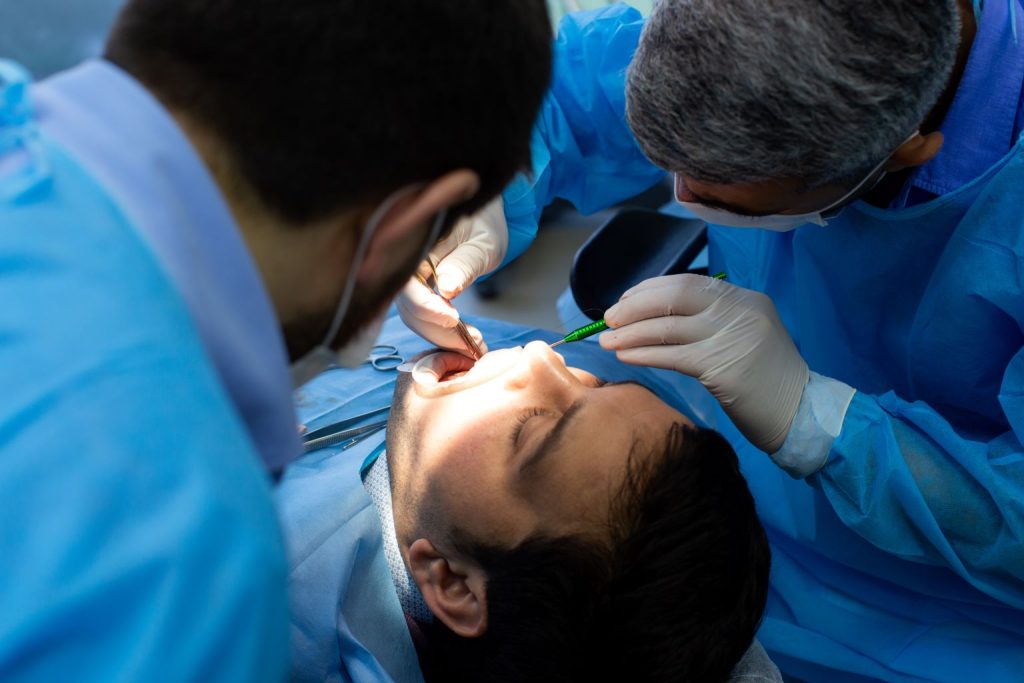When most individuals imagine needing teeth-straightening options, they often think of traditional braces or Invisalign. However, surgical orthodontics near you may be the appropriate option for patients with major jaw misalignments or complex bite conditions. Surgical orthodontics, also known as orthognathic surgery, is a specialized procedure that combines oral surgery and orthodontic treatment to improve both functional and aesthetic outcome to the jaws. If you have been looking for orthodontics near you, and wonder if braces will suffice, it might be worth exploring surgical orthodontics.
What Is Surgical Orthodontics?
Surgical orthodontics is a treatment technique to correct the improper position of teeth or jaws utilizing orthodontic appliances (such as braces) and surgical techniques performed by an oral and maxillofacial surgeon. Unlike other orthodontic treatment options, Surgical orthodontics will not just focus on the positioning of the teeth, but will also focus on skeletal discrepancies that cannot be corrected through braces.
For example, if the upper and lower jaws do not meet, you would want surgical orthodontics to reposition the jaw for adequate function and improved appearance. The various treatment strategies are designed to improve bite function and facial balance while also maintaining orthodontic results.
Who Needs Surgical Orthodontics?
Braces will not necessarily require surgery for everyone who needs them. Surgical orthodontics is usually offered to patients with:
- Severe bite problems (overbite, underbite, or crossbite) that cannot be fixed with braces alone.
- Jaw growth issues, such as a jaw that is too far forward, too far back, or asymmetrical.
- Obstructive sleep apnea, when caused by jaw positioning.
- Speech or chewing issues caused by poorly aligned jaws.
- Imbalance of the face or aesthetic concerns that contribute to low confidence and the overall structure of the face.
This is usually offered to adults or older teens, as surgery requires that jaw growth be completed.
The Surgical Orthodontics Treatment Process
The process of undergoing surgery for orthodontics generally unfolds in several stages, under the direction and coordination of your orthodontist and oral surgeon, as noted below:
- Initial Consultation
Your orthodontist will evaluate your bite, jaw position (or occlusion), and overall dental health. If surgery is an indicated path, your orthodontist will take specific imaging, photos, and/or diagnostic records for further evaluation.
- Pre-Surgical Orthodontics
Braces will likely be placed for approximately twelve to eighteen months and used prior to surgery. At this time, your teeth are adequately aligned in a position that, after the jaw is repositioned surgically, the teeth will fit together correctly.
- Surgical Procedure
The oral surgeon will perform the surgery under general anesthesia, most often to be partly admitted to a hospital or a surgical center for this procedure. The oscualtion/jaws will be newly positioned and secured together with small plates, screws, and/or wires. The surgery may take hours, depending on the complexity.
- Recovery Phase
Most patients will need a recovery phase of two to three weeks. For most OSA patients, the jaws will be repositioned for realignment. Swelling and discomfort will usually accompany this phase. These symptoms will improve with the right treatment and return to daily functional activities. During this time, it will be imperative to eat soft foods and provide appropriate aftercare.
- Post-Surgical Orthodontics
When you have recovered, at least for the first few days, braces may need to be in place for several more months in order to fine-tune your bite. Once your teeth are in final positions, the braces may be removed, and retainers will be encouraged to maintain results.
Benefits of Surgical Orthodontics
Surgical orthodontics treatment may provide life altering advantages. Benefits include:
- Improved functioning of chewing and speaking
- Relief from jaw pain and discomfort caused by misalignment
- Nonsurgical relief of jaw pain and discomfort due to misalignment
- Better oral health, as the maintenance and cleaning of teeth is easier
- Improved facial aesthetics and structures of the jaws
- Long-term stability compared to orthodontics alone in more severe situations.
Is Surgical Orthodontics Right for You?
If you have been told that your bite could not be corrected fully with braces alone, or if you are having jaw pain, cannot chew comfortably, or have a concern about your facial bones to for function or aesthetic purposes, surgical orthodontics may be a potential treatment option for you. Once again, only your trained orthodontist can provide you with the appropriate recommendations.
Conclusion
While surgical orthodontics has the cosmetic and aesthetic appearance of teeth, it is both functional and should not be reserved for hypothetical cases or shallow needs. If you are exploring surgical orthodontics treatment or want to know if you are a candidate, Girgis & Ito Orthodontics has a wonderful team to work with you. Their expertise in the field of orthodontics, combined with your special needs and experience, provides unique future oral health and aesthetics to ensure that you have a chance to experience beautiful and lasting results.





